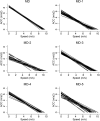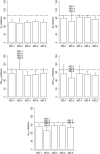Effect of playing position and microcycle days on the acceleration speed profile of elite football players
- PMID: 36357478
- PMCID: PMC9649751
- DOI: 10.1038/s41598-022-23790-w
Effect of playing position and microcycle days on the acceleration speed profile of elite football players
Abstract
The aim of this study was to analyse the differences in the A-S profile of elite football players induced by playing position and the microcycle day. Players belonged to a second division club in the Spanish La Liga competition. They were classified into five playing positions: central defenders (CD), full backs (FB), midfielders (MF), wide midfielders (WMF) and forwards (FW). Microcycle days were categorised according to the days until matchday (MD, MD-1, MD-2, MD-3, MD-4 and MD-5). Data was collected along six microcycles, including one match per microcycle. The variables analysed were: maximal theoretical acceleration (A0), maximal theoretical speed (S0), maximal acceleration (ACCmax), maximal speed (Smax) and A-S slope (ASslope). Significant differences were found within positions and microcycle day for all variables (p < 0.05). Match day (MD) showed greater values than the training sessions in A0, ACCmax and Smax (p < 0.05). The highest values for variables associated with acceleration capabilities were found in CD on MD, whereas speed variables were higher in WMF. MD-2 showed the lowest values in all variables except for ASslope. Maximal acceleration and sprint abilities are therefore affected by playing position. Wide positions showed the highest speed capacity, and CD presented a likely acceleration profile. Higher values for all variables concerning the microcycle day, were achieved on MD, and were not reproduced during training with the consequent injury risk and performance decrease it takes.
© 2022. The Author(s).
Conflict of interest statement
The authors declare no competing interests.
Figures


Similar articles
-
Quantification of a Professional Football Team's External Load Using a Microcycle Structure.J Strength Cond Res. 2018 Dec;32(12):3511-3518. doi: 10.1519/JSC.0000000000002816. J Strength Cond Res. 2018. PMID: 30199452
-
Positional Differences in Absolute vs. Relative Training Loads in Elite Academy Soccer Players.J Sports Sci Med. 2023 Jun 1;22(2):317-328. doi: 10.52082/jssm.2023.317. eCollection 2023 Jun. J Sports Sci Med. 2023. PMID: 37293421 Free PMC article.
-
Reliability of individual acceleration-speed profile in-situ in elite youth soccer players.J Biomech. 2023 May;153:111602. doi: 10.1016/j.jbiomech.2023.111602. Epub 2023 Apr 26. J Biomech. 2023. PMID: 37163953
-
Acceleration and deceleration demands during training sessions in football: a systematic review.Sci Med Footb. 2023 Aug;7(3):198-213. doi: 10.1080/24733938.2022.2090600. Epub 2022 Jun 26. Sci Med Footb. 2023. PMID: 35700979
-
Match analysis and the physiological demands of Australian football.Sports Med. 2010 Apr 1;40(4):347-60. doi: 10.2165/11531400-000000000-00000. Sports Med. 2010. PMID: 20364877 Review.
Cited by
-
Seasonal changes in the force velocity sprint profile of Spanish youth football players across age categories.Sci Rep. 2025 Apr 10;15(1):12357. doi: 10.1038/s41598-025-89501-3. Sci Rep. 2025. PMID: 40210916 Free PMC article.
-
Variation in Accelerometer-Derived Instantaneous Acceleration Distribution Curves of Elite Male Soccer Players According to Playing Position: A Pilot Study.Sports (Basel). 2024 Sep 23;12(9):263. doi: 10.3390/sports12090263. Sports (Basel). 2024. PMID: 39330740 Free PMC article.
-
A Narrative Review of the Velocity and Acceleration Profile in Football: The Influence of Playing Position.Sports (Basel). 2025 Jan 10;13(1):18. doi: 10.3390/sports13010018. Sports (Basel). 2025. PMID: 39852614 Free PMC article. Review.
References
-
- Hennessy L, Jeffreys I. The current use of GPS, its potential, and limitations in soccer. Strength Cond. J. 2018;40:83–94. doi: 10.1519/SSC.0000000000000386. - DOI
-
- Bastida Castillo A, Gómez Carmona CD, De la Cruz Sánchez E, Pino Ortega J. Accuracy, intra-and inter-unit reliability, and comparison between GPS and UWB-based position-tracking systems used for time–motion analyses in soccer. Eur. J. Sport Sci. 2018;18:450–457. doi: 10.1080/17461391.2018.1427796. - DOI - PubMed
-
- De Hoyo M, et al. Analysis of the acceleration profile according to initial speed and positional role in elite professional male soccer players. J. Sports Med. Phys. Fitness. 2017;58:1774–1780. - PubMed
Publication types
MeSH terms
LinkOut - more resources
Full Text Sources
Research Materials

